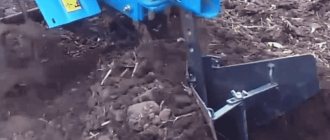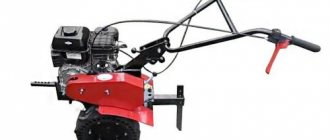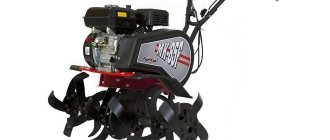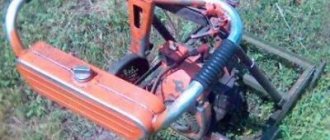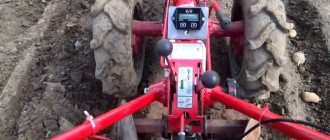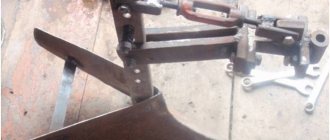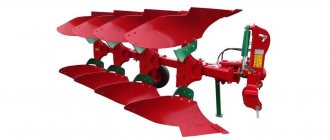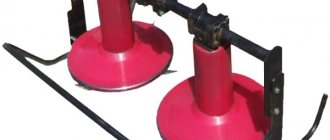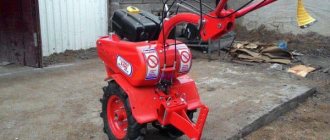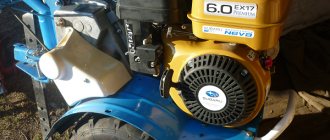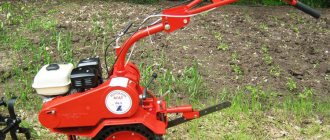Features of the attachment
The hiller for the tractor consists of:
- Metal frame;
- Attachment device responsible for coupling;
- Two stamped wheels;
- Iron pointed paws and dumps.
Thanks to tractor wheels, the load on the weeder is reduced.
The paws cut the soil to a depth of 15 centimeters. The paws are attached to the frame with a steel support. Hilling is carried out using lattice dumps. Potato hillers for tractors have the following parameters:
- Processing depth – up to 10 centimeters;
- Working width – 140 centimeters;
- Speed limit – 6 – 10 kilometers/hour;
- Travel speed – 15 kilometers/hour;
- Device dimensions – 180*122*100 centimeters;
- The weight of the canopy is 180 kilograms.
Among the most frequently used models of hillers are the domestic OKN-2x0.7 and KON-2x0.7. The hiller is suspended from the rear linkage of the tractor. The device is picked up by the SA-1 automatic coupler.
How to make a hiller for a tractor with your own hands?
Before you start creating a canopy, you need to study the drawings with the exact dimensions of the future device.
A homemade hiller is made in compliance with the following nuances:
- The finished attachment will be versatile if you carefully evaluate the customization features. The height is adjusted by a telescopic device; it must be placed in the center;
- The angle of attack is controlled by the tilt of the bed. The angle can be adjusted by changing the difference in angle between the vertical post and the front link;
- The front link is attached to the center of the rack with a hinge, this is how the bed is driven;
- The rear struts and two disks are welded to the vertical strut;
- The front link is mounted with a hinge and bolts;
- A vertical tube is welded in the center of the fork. At its end, the entire structure will be installed in a vertical rod;
- The height of the stand is adjustable with additional holes;
- Smooth discs need to be bent and the edges cleaned.
When making a hiller, it is important to take into account the dimensions of the self-propelled equipment used, which will be used for planting potatoes and their hilling.
How to use the device correctly
Planting potatoes using a hiller can be done thanks to the work of a walk-behind tractor. Not only the hiller itself is installed on the device, but also lug wheels. When such a unit operates, furrows are created. If they are absolutely even, then caring for them will be much easier. Next, potato tubers are placed in the ditch, the wheels are replaced with ordinary rubber ones, they will have to match the width of the track. Rubber wheels are necessary in order not to damage the root crops and simply fill the furrows with earth and compact them. The walk-behind tractor makes planting potatoes much easier.
Also, planting a crop can be done using a walk-behind tractor with a canopy.
Benefits of using homemade equipment
Many attachments can be made by hand. This does not require special skills or knowledge. It is enough to draw up drawings and prepare the necessary materials and tools.
Advantages of homemade hillers for tractors:
- Availability. Every gardener will be able to find structural parts and tools. Such a device will cost much less than ready-made equipment from the manufacturer;
- Efficiency. A ready-made homemade hiller is practically not inferior in performance to its market analogue. In this case, only the manufacturing quality of the device is important;
- Ease of use. The equipment is easy to install and dismantle. The work is done easily and without problems.
User manual
Before you start working with the unit, read the instructions that come with the special equipment. Check the places where the fasteners are located; if they are loose, be sure to tighten them. This way, the performance of the potato digger will not decrease.
Carry out all repairs and mandatory maintenance in advance. If any problems arise during work, turn off the tractor engine, and only after that proceed to repair the equipment.
Keep strangers away from the unit in order to protect them from injury in the first place. Do not exceed the permissible operating power of the potato digger if you do not want premature failure.
Observe the temporary operating mode, because for some units you can only work for a certain time, after which you need to give the potato digger a break.
If you work in mountainous areas, you need to reduce the speed of movement while working, otherwise the engine will overheat.
Hillers for tractors
Potato hillers for tractors are an indispensable type of equipment, the main purpose of which is to care for the tuber crops grown on the site. Most hillers are designed to work in small areas, so they are characterized by small sizes. However, even the most modestly sized guns show high productivity and efficiency, regardless of weather and operating conditions.
Characteristics, description and prices
The price for any potato planter depends on how much you plan to spend on this equipment, and a few more points:
- estimate the area that you need to plant, because there are many models of potato planters, some are suitable for sowing small plantations. And others are designed for large sowings;
- before purchasing attachments, you should carefully look at what kind of mount your tractor has, because the mounts on the canopy and the tractor may differ;
- It is worth assessing the performance of the selected potato planter, at what pace it can work; endurance is very important, especially with large volumes.
The cost of potato planters varies and depends on the number of built-in additional functions. It starts with budget options and ends with expensive models with built-in distributors of fertilizers and other vitamin and mineral supplements.
Try to buy special equipment directly from manufacturers, then there will be no price increases on the equipment.
Models of potato planters that are offered to us by manufacturers of agricultural machinery:
- An inexpensive option for the mini tractor 2 MBS-1, this unit has quite good technical data for working on small farms, the cost is 17,000 - 19,000 rubles.
- Model L - 201 (more details here), expensive, but equipped with a large capacity for potatoes and additional automatic adjustments, for convenient operation of the equipment, the cost of such equipment is 79,500 - 81,000 rubles.
- If the arable area is large, then a potato planter is needed for at least 400,000 rubles.
- Well, if you have an industrial enterprise, then only a four-row model of the S-super class is suitable, with hydraulics when lifting a bunker with potatoes; it costs starting from 550,000 rubles.
When choosing a potato planter, pay attention to the power of the tractor for which you are purchasing the attachment. If the power is low, then with the large weight of the unit, the tractor simply will not pull it.
In this case, there are options for compact and lightweight models:
- Ukrainian-made model KSC - 3, the main advantage of this potato planter is its weight - 73 kg, and even a walk-behind tractor can pull it.
- Model Xingtai 2 SM-1, heavy and equipped with additional options, capable of cultivating fairly large areas of land.
- Xingtai 2 CM – 2 weight of this potato planter from 200 kg.
Additional equipment includes:
- plowing the land and compacting it;
- loosening the soil;
- distribution of fertilizers in rads.
Model ASK – 2, the automatic planting system is additionally equipped with a Tehnos hiller, which levels the rows after planting. Model 2SM-1, due to its low weight, is suitable for swampy and viscous land areas.
Model GL 30-ECO, a good solution if the ground is rocky and hard, due to its large weight, the unit will be processed without problems. Model SK 2-130, heavy and equipped with forged wheels, is suitable for dense, dry soil. Before choosing a potato planter, look not only at its weight and characteristics, but also at the wheelbase and ground clearance, because the soil also has its own properties, it can be:
Depending on this, you need to choose the right unit with high clearance or on rubber wheels if the soil is marshy. And for dry soil, steel wheels with a small clearance are suitable.
Some landowners are wondering which potato planter is better: an automatic or semi-automatic one.
Well, let's look at both options.
The semi-automatic model requires the mandatory presence of an assistant tractor driver, as it gently regulates the process of distributing potatoes and mineral fertilizers.
Functions of a hiller on the farm
For agricultural purposes, a tractor-mounted hiller can perform several important functions at once.
It is used to perform the following work:
- moving soil from rows to beds;
- loosening the soil on the site;
- cutting furrows;
- soil cultivation.
An important advantage of most hillers for tractors is that their owners can adjust the working width of the area. This allows you to use tractor equipment in certain conditions.
Design features of the equipment
The tractor hiller has a very simple design. It is based on a rectangular steel frame. All other structural parts are attached to the frame, as well as a hinged mechanism through which the hiller is mounted on the tractor.
As a rule, a tractor-mounted hiller is equipped with cast metal wheels designed to reduce the load created on the rear of the equipment. The role of the main working element of the tool is played by the pointed paws. In the process of moving the hiller, they cut the top layer of soil to a depth of 5 to 15 cm. The paws are attached to the supporting frame using steel supports.
Specifications
If you take any potato planter, the design will be basically similar:
- main frame with some drive wheels;
- container for loading potato seeds for planting;
- coulters necessary for making furrows for planting seeds;
- one or more planting brackets, with cups or spoons;
- furrow buryers.
Otherwise, the only differences between the models are the presence of additional adjustments and functions of the potato planter. The operating principle is the same for all models.
From the bucket, the seeds fall onto the cup, then are carefully placed in the furrows, and then buried, forming a row. The distance between tubers is adjustable, from 20-40 cm, and the distance between rows is most often 60 cm.
2 MBS
Potato planter 2 MBS – 1, suitable for mini tractor, power – 4.8 km/h,
- single-row plants to a depth of 80-120 mm,
- There are two tanks for seeds and fertilizers,
- seed tank volume – 40 kg,
- distance between tubers – 25-27 cm,
- working productivity – 0.1-0.3 hectares,
- tractor power required - 12-18 horses, weight - 102 kg
KS – 2MT
The KS-2MT unit is suitable for a standard MTZ-132N tractor. The MTZ model range can be studied here.
- two tanks for sowing seeds and fertilizers;
- double-row, width adjustable from 65-75 cm;
- potato planter weight – 115 kg.
Model KSM-1 - suitable for tractors with a power of 10-20 horses, potato planter output - 0.1 - 0.14 hectares per hour.
S-239, S-239-1
- double-row weighing 205 -223 kg;
- depth of planting potato seeds – from 6 to 12 cm;
- adjustment of the distance between tubers – 29-32 cm;
- maximum potato load up to 180 kg;
- working productivity – 0.3 – 0.45 hectares;
- operating speed – for S-239 is 4-6 mph, for S-239-1 is 12 mph.
L – 201
- width between rows to choose from – 62.5, 70, 75 cm;
- tank capacity – 250 kg;
- operating speed – 10 mph;
- working productivity – 0.57 – 1.14 hectares per hour;
- unit weight 380 kg.
Make the right choice by studying all the characteristics of potato planters.
Classification of hillers for tractors
All commercially available hillers for tractors are divided into several types.
According to the principle of operation, equipment is classified into the following types:
- Lister hillers are among the simplest devices. The design of such guns consists of two spread wings connected to each other using a thin rack. The presence of the latter protects the device from overload when going deep into the ground. In lister equipment, it is impossible to adjust the width of the plot, therefore, when using it, you should adjust the width of the bed to the capabilities of the hiller;
- disc hillers - in essence, these designs are universal equipment. The best options are considered to be disc hillers made of alloy steel and equipped with rolling bearings;
- hillers for tractors with adjustable working width - this equipment is one of the most popular agricultural devices. It is suitable for processing almost any area;
- propeller hillers - these structures work on a very simple principle: while moving the equipment, the special propellers provided in its design begin to rotate, thereby crushing the soil and throwing it out of the rows directly into the beds.
Potato planter for tractor T-25: potato planter T-40 and homemade for MTZ-82
Everyone who is involved in even small-scale agriculture always thinks about how to plow the land and plant the crops. Of course, if the garden is small, you can dig it up by hand, but what should those who have arable land of several tens or hundreds of hectares do?
For high-quality cultivation of the land you need good equipment. What kind of equipment you need depends on what you are planting on the ground. For various grain crops you need: tractors with diggers (for example, the Belarus minitrator), combine harvesters, Kamaz trucks for transporting grain (the model range is here) and additional auxiliary materials.
How to make a hiller for a tractor with your own hands?
A hiller for growing potatoes is quite easy to make yourself. However, before this you will need to carefully study the drawing, which will indicate the dimensions of all parts used for assembly.
The further algorithm of actions is as follows:
- First of all, you need to select 2 identical lids from ordinary saucepans. It is very important that each of them is metal and without an enamel coating. The diameter of each lid should be from 40 to 50 cm. Taking into account the fact that the potato root system goes deeper into the ground no more than 20 cm, this size of lid will be quite sufficient;
- Next, you need to sharpen the edges of the lids evenly. If the lids used are straight, then their edges will need to be bent slightly by tapping them with a hammer;
- To make it easier to operate the hiller for a tractor, it is better to make a small support frame in advance to move it around the site. Its presence will optimize the operation of plowshares that loosen the soil. To make the frame, you can use steel pipes and bushings. Having made the support frame, you will need to attach the wheels to the axle at the bottom of the frame.
The finished homemade hiller will need to be painted to protect its metal parts from corrosion and subsequent rotting. After this, the design can be tested in practice. To do this, the weeder is connected to the hydraulic system of the tractor using a belt drive. Next, you can begin testing the device. If the hiller parts do not wobble during movement, then the equipment is completely ready for work.
A self-made hiller can be installed on a Dong Feng mini-tractor and other low- and medium-power units. The main thing is that the agricultural machine does not succumb to excessive loads when working with homemade equipment.
How a hiller helps in growing potatoes, we learn how to do it ourselves for a walk-behind tractor
It has so happened historically in Russia over the past 300 years that such a crop as potatoes is given exceptional importance. Potatoes become especially important in those years when dry spring harvests and rainy summers have an extremely negative impact on wheat yields. It’s not for nothing that they say that potatoes are the second bread. Therefore, the task facing agricultural producers from time immemorial was initially set in such a way that it was possible to obtain the highest possible potato yield.
Specifics of growing potatoes
Potatoes, as an agricultural crop, are considered by experts to be unpretentious to climatic conditions. Most of all, as you know, the Colorado potato beetle harms it. But climatic factors can only significantly slow down the growth of its roots, thereby reducing the yield of this crop. To prevent low yields in agricultural technology such as growing potatoes, an agronomic technique such as hilling potatoes has long been used.
The technique is not new, it has been known since the appearance of potatoes in Europe. And it was probably used when growing potatoes by Indian tribes in North America.
But since in modern conditions the cultivation of potatoes is of an industrial nature, that is, large areas are allocated for sowing seeds by producers of this crop, then, accordingly, completely different requirements apply to cultivation work, namely, increasing the productivity of such agricultural work through the use of mechanization means . In such events, a tractor has long replaced hard and monotonous work with a shovel or hoe.
How to make your work easier
But such a means of mechanization is beyond the means of most summer residents and small farmers. Today, the Internet with its limitless information capabilities can help how to plant potatoes for this category of rural producers. It is the World Wide Web that can most effectively answer a farmer, limited in funds to buy a tractor, to the question of how to hill potatoes using his own agricultural equipment, and also from auxiliary materials that are no longer needed on the farm.
And in this case we are not talking about a walk-behind tractor, although it is quite effective for such agricultural work, and will certainly be useful for those who have decided to hill up potatoes in their own plot of land in the shortest possible time and with the least amount of labor. In this case we are talking about a hiller, which is essentially an attachment that lifts loosened soil and then sprinkles it on potato bushes.
This agronomic technology is the main biological essence of this cultivation technique. With this sprinkling, the soil around the bush is saturated with oxygen and moisture, which promotes increased growth of stolons, lateral shoots, and therefore an increase in the number of tubers in the bush. This happens due to the effect of aeration, that is, as mentioned above, the enrichment of the soil with oxygen.
We make the hiller ourselves
The impatient reader quickly wants to know how to get such a hiller into his hands. The answer is brilliantly simple, you need to make such a hiller with your own hands. And the most interesting thing that is most likely to please our savvy fellow citizens is that this does not require any special tools or equipment.
So, the epic called a homemade hiller begins with a search for pot lids that are unnecessary on the household. It would be best if the lids were not enameled, but metal. The required diameter is approximately 40-50 cm, given that the potato roots grow into the ground no more than 15-20 cm. Next, you should sharpen the blades of the lids, and in our case these are the hiller discs on a grinding machine. If the lids are straight, they need to be slightly bent to one side using a hammer.
Homemade hiller for tractor
Homemade hillers with hedgehogs for the tractor.
Hello to all DIYers! Here is one of my homemade tractor attachments for your viewing pleasure. I made these hillers 2 years ago, they work flawlessly, photos of production are attached.
I used Autogen to cut out these circles.
And here are the homemade hillers after painting.
The hillers work perfectly, I processed potatoes for two seasons.
